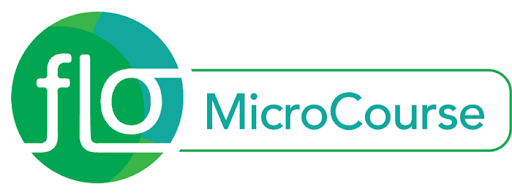Chapter 7: FLO MicroCourses
FLO MicroCourses

Synopsis / abstract
Title: Facilitating Learning Online (FLO) MicroCourses
Purpose: These short courses provide an opportunity to dip into the FLO experience and leave with something practical and useful for your own teaching practice. Each MicroCourse focuses on a different topic; new MicroCourses are added as topics are put forward by educators or suggested by emergent trends. This enables educators to selectively explore relevant issues, tools and strategies. The spirit of FLO MicroCourses is to offer an open and flexible experience within a scheduled framework.
Mode: A facilitated asynchronous online course
Length: Five days
Expectations – facilitators: Facilitators provide support throughout the course and foster a comfortable and inviting space to encourage sharing of unfinished work for peer review. The facilitator does not need to be an expert in the subject area.
Time requirements for facilitators: The time commitment varies depending on the number of facilitators, their prior experience, and the number of participants. Typically, facilitators are also involved in the design of the course materials unless they are re-using a previously implemented MicroCourse. Each facilitator can expect to spend at least 5 hours during the week, more if they are providing direct feedback on the participants’ work.
Expectations – participants: Participants are expected to follow the steps for the course activities and can choose how detailed they wish to make their drafts and prototypes. However, there is an expectation that participants reciprocate with feedback; if they are offering something for peer review, they should also provide feedback to others.
Assessment: Through peer review, participants give and receive feedback, reflect on what is useful and relevant, and refine their prototypes. A peer feedback rubric is included to guide the process of giving feedback.
Time requirements for participants: Participants should expect to spend 5 hours for course activities. Those with no prior online teaching and learning experiences can expect to invest more time.
Primary resource for facilitators: All MicroCourses contain familiar elements: templates for designers and facilitators to use and modify for their specific topic. After a MicroCourse is implemented, it is made available as an Open Educational Resource (OER). Facilitators can then download a course, implement it, or completely re-work it for a new topic.
What are FLO MicroCourses?
Facilitating Learning Online (FLO) MicroCourses are five-day courses that focus on a single topic. Participants engage in a five-step process to create a draft or prototype, and then give and receive feedback. Participants then leave with something practical and useful for their own teaching practice, whether it’s of their own creation or borrowed from their peers.
We created the concept of short FLO MicroCourses to appeal to more participants than could attend a longer course. Many participants reported being astounded at how much they learned from their first full intensive FLO course (such as FLO Fundamentals or FLO Design), and how valuable participatory and collaborative learning was. However, the length of the foundational FLO courses could be a barrier for some people. For example, it could be challenging for faculty to devote five weeks to complete FLO Fundamentals during a semester with a full teaching load. Therefore, FLO MicroCourses offer a dip into the FLO experience without the full-time commitment.
Here are some suggested topics for MicroCourses:
- Make your course intro video
- Creating and using rubrics
- Experience and design a community-building activity
- Write your teaching philosophy statement
- Design course evaluation surveys
- Metacognition: Rethinking the role of thinking in learning
- Writing a compelling discussion prompt
- Create an explainer video
- Acknowledging traditional Indigenous lands
- Design with Liberating Structures
- Teach with stories
Benefits of MicroCourses:
- They’re short, manageable chunks of productive learning.
- They provide a taste before committing to a full FLO course and allow participants to experience facilitated, active, peer-supported, outcome-based learning.
- They provide an opportunity to practice facilitation.
As outlined in Chapter 3, the mentorship model for preparing future FLO facilitators requires that we provide opportunities to practice. These short courses are a smaller time commitment for FLO facilitators than the 3-, 4- or 5-week courses, yet they provide a rich experience in both activity planning and facilitation. Offering the courses frequently, and working in teams, opens up more possibilities.
Learning outcomes
A MicroCourse provides a framework for introducing any number of topics and projects. As such, the learning outcomes change from one course to the next.
Participants
Participants who take FLO MicroCourses are typically full- or part-time instructors at post-secondary education institutions. Participants may also include those who support teaching faculty such as instructional/learning designers, educational consultants and learning technologists. Other potential participants include graduate students, consultants from the private sector and staff who work at for-profit or non-profit organizations.
There are no prerequisites for MicroCourses so participants could potentially come from any domain.
FLO MicroCourses work well with 10 or more active participants which allows for sufficient variety in the prototypes and more exposure to new ideas and examples. The course model can certainly accommodate more than 10, mainly because of the peer review element. To date, we have not placed a limit on enrolment and fully expect that not all participants will be active. Facilitators do not reach out to participants if they aren’t engaging in the course, such as they would to participants of other FLO courses.
Technology
General recommendations for technology can be found in in Chapter 3: Tools to Support FLO. Other tools can be considered on a per course basis depending on the topic of each MicroCourse.
The course content and layout
The FLO MicroCourse OERs from BCcampus are complete 5-day courses with a collection of content, activities and resources. The BCcampus MicroCourses are open to the public. Anyone can access the courses without enrolling. Also, past offerings of MicroCourses remain open for browsing. As mentioned, topics change from one course to the next; however, these course elements remain consistent.
MicroCourse Handbook
This resource outlines details about participation, course tools, and course content.
Activity Packet – 5 steps / 5 days

The Activity Packet is the core resource for MicroCourses. From this page, participants follow steps that include research, creation, review and feedback.
The activity packet includes five steps. This is an example from the ‘Write a compelling discussion prompt’ MicroCourse. You can modify the steps to suit the top of your offering, but sticking to five steps helps keep the courses consistent.
- Research phase
- Step 1 – What? Why? What have others done?
- Creation phase
- Step 2 – Draft it!
- Step 3 – Post it!
- Review and feedback phase
- Step 4 – Review and engage.
- Step 5 – Give and receive feedback.
Announcements forum
This forum is for facilitators to welcome participants, post daily reminders and commentary on progress, and close the course. These posts are more likely to be noticed because they are in their own separate forum.
Questions & Answers / Open forum
This forum is where you ask for (and give) help/clarification/guidance. While there will be some overlap with the conversations that take place in the Sharing & Feedback forum described below, having this Q&A as a separate forum makes it easier to zone in on precisely what is relevant at that moment.
Sharing & Feedback forum
This forum is used for sharing prototypes and providing feedback. It includes prompts for presenting the work as well as for providing peer feedback.
Course assessment
There are no set requirements for completing MicroCourses. However, all participants who share prototypes receive feedback from peers and/or the facilitators. Guidelines for providing quality feedback are outlined, so in that sense, it is a self-assessment tool for rating feedback efforts. (See FLO MicroCourse Peer Feedback Rubric.)
Facilitator task list: What you need to do before, during, and after the course
The successful hosting of a FLO MicroCourse requires an organized approach to planning and facilitation. The following suggestions will support the facilitation team to successfully implement the course.
Two heads are better than one

This is what Robin Leung had to say in his “lessons learnt” report after his first MicroCourse co-facilitation experience:
I learnt that you need a co-facilitator that balances with your life well. I had a more technical background and my co-facilitator had more of the facilitation background. I am a night owl (catching most of the activities at night), and she’s the early riser (catching most of the activities in the day time). I think we complemented one another very well.
— Robin Leung[1]
Before the course begins
Promote the course
Think about ways to advertise your course in a way that appeals to individuals from a variety of backgrounds and disciplines. The more diversity in your course the richer the discussions and feedback. In your communication, emphasize the informal and practical nature of the course, as well as the potential to leave with a full bag of ideas and examples.

Consider using social media to help build interest, to share snippets from the course while it is in progress, and to post highlights from participants’ feedback. This is especially helpful as a way to sustain interest if you offer the MicroCourses as a series.
Review the MicroCourse Handbook
This handbook is intended to be very general so that it can be used in every MicroCourse. However, you may need to remove any information that is not relevant to your offering.
Adjust the course dates to match your offering
In the BCcampus version of the course, the dates are listed on the main page as well as in the polling activity (within the LMS) that we use for registration. Your learning management system may also require dates to be set for each course.
Invite self-enrolment
You may choose to organize the registration process in a way that suits your institution. However, we have found that self-enrolment works well for this course because we are not limiting the enrolment.
Edit the Activity Packet
The activity packet should include all the information a participant needs to complete the five steps. This includes essential details, but also links to other resources and forums mentioned in the steps.

Keep the activity packet concise. It is not meant to be a dumping ground for content related to your topic. Encourage exploration of the subject matter and perhaps link to a few key readings.
Create a co-facilitation plan
There is no shortage of ways to spend your time as a facilitator. With a plan for how you will divide up the tasks, you can maintain a manageable workload and avoid overstepping. For example, two concurrent responses containing similar information to a participant’s question is not value-added. You may decide to alternate days, allowing for breaks from the course or more time to simply sit back and enjoy browsing the contributions. Another possibility is to divide participants into groups and each facilitator declares responsibility for individuals in their group. This way you can ensure that all participants receive some form of acknowledgement of their work.
Open the course
Open the course a few days before the start date. This suggestion is optional, but we have found that participants are ready to roll up their sleeves on day one of the course if given this opportunity to preview what’s ahead.
Decide how participants will become acquainted
A 5-day course does not allow much time for community building! So, you may wish to create a shared Google Doc and ask everyone to respond to one or two “about me” questions. This way, everyone can stay on schedule and use their time wisely. In Moodle, we have used the Glossary tool for introductions because it avoids the subscription issues that can sometimes come with using forums. It also gives better display and sorting options and allows comments.
During the course
Write a welcome post
You may have already posted a “doors are open” announcement to invite participants to see what is ahead in the week to come. Your post on the first day should include details about what participants should attend to immediately. This conveys the fast-paced nature of the course, and zones in on exactly what is relevant for that day.
The tone of your post is important. Avoid pressuring participants to comply with course deadlines, or suggesting they are only welcome if they are committed to following the activity plan. This is an informal, adult learning environment; expect that individuals will have their own agenda.
Establishing a protocol for facilitator posts can help them to be noticed and reinforce the timeframe. For example, the subject heading for this post is Day 1: Rise and Shine. The next day’s post was Day 2: Dig In, and so on.

Post Example: Day 1: Rise and Shine
By Sylvia Currie – Monday, 17 September 2018, 7:08 AM
With MicroCourses we just jump right in. Let’s do this!
Almost everything you need is in the Activity Packet.
Today is all about the research phase: steps 1 to 6. The recommended timeframe for completion is, gulp, today! Don’t worry, some of it is quite light, and mostly requires solo pondering and reflection.
Thanks to everyone who posted a quick hello over the weekend! Drop a comment or two if you feel compelled.
Questions? Ask anything, anytime in the Questions & Answers form.
Your facilitators,
Sylvia Currie, Bettina Boyle, Jacquie Harrison
Acknowledge the arrival of participants
How you do this will depend on the way the course is set up. If you have included an introduction activity, facilitators should quickly respond to those who have taken this first step. If there is no planned way of “arriving” to the course, you can still send direct messages or personal email. Any effort to reach out early in the course will help establish facilitator presence.
Attend to the calls for help
Ideally, if the activity packet is clearly laid out, there won’t be too many of these. However, you should respond to any questions pertaining to the course process as quickly as possible. Make sure you coordinate with your co-facilitator who will respond.
Monitor the sharing of drafts and prototypes
It’s exciting when the prototypes begin to roll in! What is the facilitator’s role when peer review is the centre of the course design? This is an area that requires balance and judgment. The best advice is to:
- Be concerned only if an uncomfortable amount of time goes by without any replies.
- Only offer genuine feedback.
- Resist the urge to be thorough, but be clear that you’re only commenting on one or two aspects of the artifact.
- Invite participants to jump in and elaborate, using your curious voice: “I can’t wait to read others’ first impressions and advice.”
Also, consider the impact if facilitators only respond to one or two contributions. Will others feel neglected? Quite possibly! So, it’s important to establish expectations that you may acknowledge contributions but not provide comprehensive feedback. After all, other participants might have more subject matter expertise than you, and they will provide valuable feedback.

Jumping in too quickly to offer your advice or feedback, or to respond to questions, might discourage others from engaging.
Continue with daily facilitator posts
Plan to begin each day with a forum post (announcement) that shines a light on progress, and brings attention to where participants should be in the process.
Post Example: Day 2: Dig in!
By Jacquie Harrison – Tuesday, 18 September 2018, 9:43 AM

Good morning!
It’s so nice to see you all in the quick hello. We are a talented group!
If you are following the suggested timeline for this MicroCourse, you spent some time thinking about what rubrics are, maybe looking at few examples and considering how and why you could use a rubric in a course that you teach.
Now, it’s time to roll up your sleeves and develop a first draft. We’re moving in to Step 7 in the Activity Packet.
Please post your draft rubric in the Sharing and Feedback by Wednesday evening.
Happy developing!
Harvest the gems!
Throughout the course, it’s useful to create a routine that brings together the resources that the participants are sharing. Often this falls on the facilitators, but certainly encourage everyone to compile and organize artifacts.
After the course
Write a closing post
Facilitators need to gauge the opportune moment to wrap up this five-day course. Since there can still be a lot of buzz on the Friday, Saturday could be better so it doesn’t look like you are checking out early, and there may still be participants busily working away on course activities. In any case, open up the opportunity for participants to share their revised prototypes even if it is past the moment of receiving further feedback. You might also suggest they can still offer encouragement and appreciation to their classmates. Also, remind participants that the course remains open, if that is how your establishment chooses to handle these courses. If you have this information, mention the upcoming MicroCourses; word of mouth is the best way to build interest in open learning opportunities!
Evaluation survey
Remind participants about the importance of providing course feedback. So much can be gleaned from these surveys! A sample basic evaluation survey can be found in Appendix 3: Generalized Course Evaluation Survey.
Facilitator debrief
Don’t part company with your co-facilitators without scheduling a debrief. It’s important to share experiences and ideas about the facilitation process, otherwise you are destined to repeat what could have been improved! Keep notes and share them with other facilitators, if possible.

Here are some snippets from past debriefs:
“Maybe we could be more explicit? Give them a heads-up about what they can’t do on mobile devices?”
“Not really useful to share tools that are only available within big institutions, or that require logins that don’t adhere to workplace guidelines”
“Opening up the course early made a big difference. Let’s do that again next time!”
Summary report
Publishing a summary of what transpired can help participants feel a sense of accomplishment, and can also help build interest in upcoming MicroCourses. Consider including participation data, quotes from the evaluation survey or forum posts. For example, this graph clearly illustrates a high level of participant engagement in the “Creating and using rubrics” MicroCourse — probably higher than anyone realized.[2]

This collage captures the thumbnails of videos shared during the “Create your course intro video” MicroCourse and sparked up the summary report.

Image descriptions
| Date | Member Views | Member Posts |
|---|---|---|
| 14 September 2018 | 0 | 0 |
| 15 September 2018 | 95 | 10 |
| 16 September 2018 | 105 | 5 |
| 17 September 2018 | 430 | 90 |
| 18 September 2018 | 155 | 50 |
| 19 September 2018 | 440 | 125 |
| 20 September 2018 | 395 | 170 |
| 21 September 2018 | 200 | 80 |

